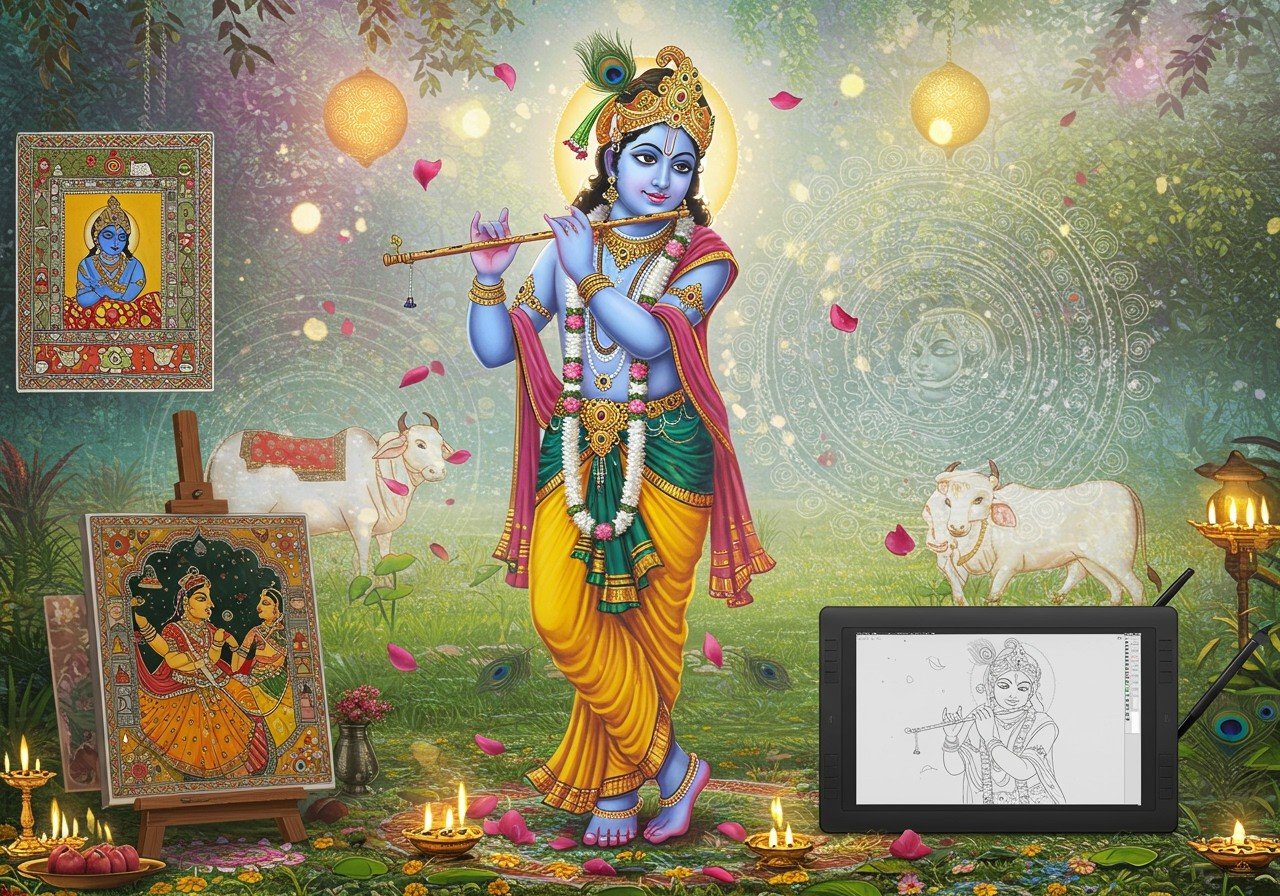Celebrating Krishna Through Art: Paintings, Drawings, and Rangoli

Krishna, a central figure in Hindu mythology, has profoundly influenced Indian art for centuries. This blog delves into the celebration of Krishna through various art forms, including paintings, drawings, and rangoli. We’ll explore the historical context, techniques, and cultural significance of these artistic expressions.
The Historical Context of Krishna in Art
Krishna’s portrayal in art has evolved over time, reflecting Indian aesthetics and cultural values. Early depictions can be found in ancient temple frescoes and manuscripts. The Bhakti movement significantly popularized Krishna-themed art across India. Royal patronage, particularly in Mughal and Rajput courts, further promoted Krishna-centric artworks. Regional styles, such as Mysore and Tanjore paintings, also showcase beautiful depictions of Krishna.
While colonialism impacted Indian art, the 19th and 20th centuries witnessed a revival of traditional art forms. Artists like Raja Ravi Varma introduced Krishna to a wider audience. Festivals like Janmashtami, as noted by Indiatimes in their article “20+ Best Janmashtami 2023 Drawing and Rangoli Ideas,” continue to inspire Krishna-themed artworks even today.
Krishna in Paintings
Krishna paintings boast a rich tradition and remarkable diversity.
- Pichwai paintings: Known for their intricate details depicting events from Krishna’s life, Pichwai paintings showcase vibrant colors and fine brushwork, often portraying Krishna with Radha and gopis.
- Madhubani paintings: These paintings employ vibrant, geometric patterns to portray Krishna, often depicting scenes from his childhood and his divine leelas.
- Kangra paintings: These emphasize the romantic tales of Krishna and Radha, using delicate brushwork and soft color palettes to create an atmosphere of love and devotion.
- Patachitra paintings: These narrate Krishna’s adventures through a series of panels, much like a visual storytelling tradition passed down through generations.
- Tanjore paintings: These depict Krishna with ornate, golden backgrounds, showcasing the opulence and grandeur associated with his divine status.
Contemporary artists often blend traditional motifs with modern techniques, adding fresh perspectives to Krishna art.
Krishna in Drawings
Krishna-themed drawings capture his divine essence through various styles and mediums.
- Line drawings and sketches: These offer minimalistic elegance, capturing the essence of Krishna’s form with simple yet evocative lines.
- Ink and charcoal: These create dynamic and expressive portraits, playing with light and shadow to bring out Krishna’s personality.
- Folk art techniques (Warli and Gond): These depict Krishna’s stories in a unique and stylized manner, using traditional patterns and motifs to create visually appealing narratives.
- Book illustrations: These bring Krishna’s tales to life for younger audiences, making them accessible and engaging.
- Digital tools: These allow contemporary artists to create striking illustrations, pushing the boundaries of traditional art forms.
Anatomical accuracy and emotional expression are crucial elements in Krishna drawings, making them both educational and engaging.
Krishna in Rangoli
Rangoli, a vibrant folk art tradition, plays a significant role in celebrating Krishna, especially during festivals. As mentioned in sources like “Krishna Janmashtami Rangoli designs with colours and dots 2025,” rangoli is an integral part of festivities.
- Historical origins: Rangoli’s historical origins reveal its evolution as a decorative art form deeply rooted in Indian culture and traditions.
- Regional variations: Different regions have unique rangoli styles, such as Kolam in Tamil Nadu and Alpana in West Bengal, each with its distinct patterns and techniques.
- Symbolism: The patterns and colors in rangoli hold symbolic meanings, invoking Krishna’s presence and blessings. Specific colors and motifs are often used to represent different aspects of Krishna’s personality and stories.
- Creating Krishna rangoli: Creating Krishna rangoli involves sketching designs, often inspired by traditional motifs, and filling them with colored powders, flowers, or other materials.
During festivals like Diwali and Janmashtami, homes are adorned with elaborate rangoli designs featuring Krishna motifs. These designs are not merely decorative but also hold spiritual significance, inviting positive energy and divine blessings. Rangoli-making is often a communal activity, bringing people together in celebration.
Innovative Touches
Innovations in rangoli include the use of eco-friendly materials and digital design tools, allowing for modern interpretations while respecting tradition. This blend of old and new ensures the continued relevance of this art form for future generations.
Celebrating Krishna Through Art at Poojn.in
Poojn.in, India’s leading online store for cultural and religious goods, offers a wide selection of products to enhance your Krishna celebrations. You can find beautiful Laddu Gopal idols, Radha Krishna statues, and other holy idols perfect for your home. We also offer a variety of pooja items and rangoli supplies to help you create stunning Krishna-themed art. Visit poojn.in today to explore our collection and bring the divine presence of Krishna into your home.
FAQs on Krishna in Art
What are common themes in Krishna paintings? Common themes include Krishna’s childhood pranks, his divine love with Radha, and his heroic deeds in the Mahabharata. These themes depict various aspects of Krishna’s personality and stories, from his playful nature to his divine role.
How can I start drawing Krishna? Begin with simple sketches of his face, focusing on his serene expression and iconic features like the peacock feather and flute. Practice will improve your skills over time. There are many online resources and tutorials available for beginners.
What materials are needed for Krishna rangoli? You’ll need colored powders, chalk, stencils, and sometimes flower petals. Vibrant colors enhance the festive atmosphere. Natural colors are often preferred for traditional designs.
The cultural significance of these art forms is immense, enriching personal spaces and community celebrations. Cherishing these traditions ensures the legacy of Krishna in art remains vibrant and meaningful for generations to come.
